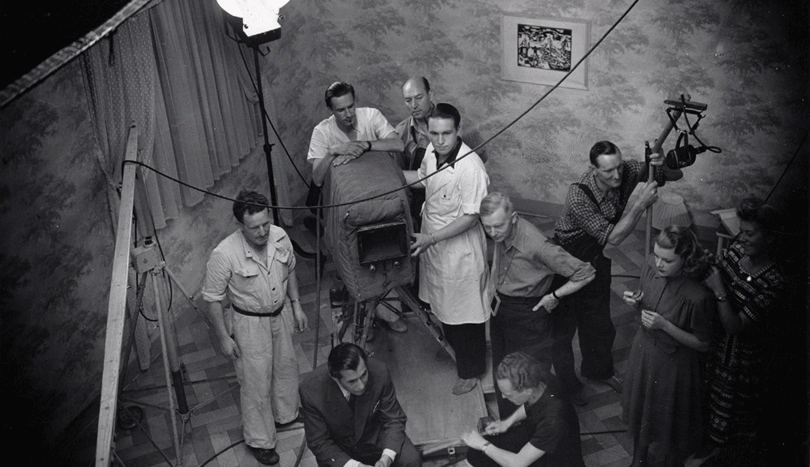The year before Leaves from Satan’s Book premiered at Paladsteatret in Copenhagen, 1921, Dreyer delivered the following broadside against the Danish film industry in the Dagbladet newspaper, "The sad lot of Danish film has been to always keep flogging a horse that the rest of the world has long since left for dead." He continues,
A dubious odour still clung to Danish film and frightened away the intelligence – this odour, which is so persistent that audiences in our more discerning neighbouring countries still hold their noses at the mere sight of a poster advertising a Danish film.
The article was headlined Svensk Film (Swedish Film). Dreyer considered Swedish films to be setting a new artistic standard, unlike the Danish assembly-line fare.
The golden age of Swedish films
While Danish films – in particular, Nordisk Film – fell into crisis after World War I, Swedish films were enjoying an artistic golden age. The company behind many of these Swedish films was AB Svenska Biografteatern, founded in 1907 to import and produce films and operate cinemas. The enterprising Charles Magnusson took charge of the company in 1909 and hired the directors Victor Sjöström and Mauritz Stiller for AB Svenska Biografteatern in 1912. Sjöström and Stiller would become two of the most prominent and admired directors of the Swedish golden age. In 1919, AB Svenska Biografteatern merged with Filmindustri AB Skandia with financial backing from the industrialist Ivar Kreuger. Renamed AB Svensk Filmindustri (SF), the new corporation was Sweden’s biggest film company with 70 cinemas and equity of 35 million Swedish kronor.
Two great Danes go to SF
The same year Dreyer wrote that article, he was hired by SF. He considered it a great joy to be affiliated with Swedish cinema, which he admired,
In those years I had just immersed myself in the great Swedish films, especially the works of Sjøstrøm, which had impressed me with their deep gravity, humanity, warmth and lyrical tone (autobiographical note, 1939, in M. Drouzy: Kildemateriale til en biografi om Carl Th. Dreyer, p. 66, 1982).
Over the summer of 1920 Dreyer directed The Parson’s Widow for SF, shooting on location in Lillehammer, Norway. Dreyer was not the only Danish director in the years around 1920 to make films for Swedish companies. Benjamin Christensen, the other great Danish silent-film director, made Häxan (The Witch) (1922) with capital from SF. The following year Christensen played the lead in Dreyer’s German-produced Herman Bang adaptation Michael (1924). Moreover, another Danish director, Robert Dinesen, directed two Swedish films, Jefthas dotter and Ödets redskap, with Swedish actors in Palladium’s studios in Denmark in 1919.
A new chief with artistic ambitions
Dreyer made one more film for SF, but not until more than 20 years later. In 1942 Carl Anders Dymling (1898-1961) was named the new chief of SF. Dymling, an academic with a special interest in English literature and Shakespeare, was the former head of Svensk Radio’s drama department. As in Denmark, the Swedish film industry flowered during the war, when very few foreign films were allowed to be imported. SF’s film output rose in the 1940s to between 30 and 40 films a year. Dymling saw this situation not only as an immediate competitive advantage for Swedish films but also as an opportunity to establish an artistic foundation for ushering in a new heyday for Swedish cinema. Dymling made the company’s legendary silent-film director Victor Sjöström his artistic leader and SF started moving away from the popular folk comedies it had been churning out in the 1930s. In light of Dymling’s ambitious project, it does not perhaps seem so strange that he hired Dreyer, who was known as an uncompromising, artistically ambitious director.
A Swedish fiasco
Dreyer had several reasons to leave for Sweden in the winter of 1943. He wanted to sell Day of Wrath to the Swedish market and he also had a desire to make a film in Sweden. Though Dreyer did not sell Day of Wrath, he was hired by SF to develop a script and possibly direct a film. Dreyer, for his part, wanted to adapt Louis Verneuil’s 1928 play Monsieur Lamberthier, but the rights to the play had already been acquired by the Warner Bros. studios of America and instead Dreyer was assigned to prepare and direct Two People, based on a play by the Swiss writer W.O. Somin, Attentat (Close Quarters), 1935. Somin’s play offered Dreyer an opportunity to conduct an experiment he had long been considering – making a film with just two characters in a story taking place over a short period of time in a defined space.
The production was not without problems. Dreyer had to rewrite the script for the film and he did not get the actors he wanted. When the film was in postproduction, Sjöström and Dymling again meddled, including on the issue of what music to use. Moreover, without Dreyer’s consent, they put a scene back in that he had cut. Dreyer vehemently protested all these moves, but there was nothing he could do. Two People premiered in March 1945 to generally negative reviews and closed after five days. Dreyer later renounced the film.
AB Svensk Filmindustri still exists today. The company celebrated its 90th anniversary in 2009.
By Isak Thorsen | 11. November
